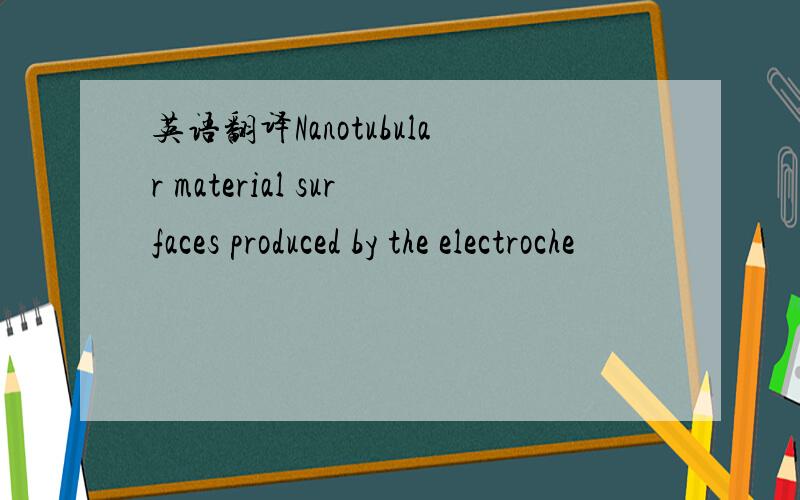英语翻译Nanotubular material surfaces produced by the electroche
来源:学生作业帮 编辑:搜狗做题网作业帮 分类:英语作业 时间:2024/05/12 14:03:31
英语翻译
Nanotubular material surfaces produced by the electrochemical formation of self-organized porous structures on materials such as aluminum and silicon have attracted significant interest in recent years.While scientific thrust is often directed towards the elucidation of the principles of the self-organization phenomena,technological efforts target applications based on the direct use of the high surface area,for example,for sensing or controlled catalysis,exploit the optical properties in photonic crystals,wave-guides,[9]or in 3D arranged Bragg-stack type of reflectors.The highly organized structures may be used indirectly as
templates for the deposition of other materials such as metals,semiconductors.or polymers.\x05Over the past few years,nanoporous TiO2structures have also been formed by electrochemical anodization of titanium.Although several applications have been proposed,a wider impact of these structures has been hampered by the fact that the layers could only been grown to a limiting thickness of a few hundreds of nanometers.
Herein we demonstrate for the first time how high-aspect-ratio,self-organized,TiO2films can be grown by tailoring the electrochemical conditions during titanium anodization.Figure 1 shows scanning electron microscope (SEM) images of self-organized porous titanium oxide formed to a thickness of approximately 2.5 mm in 1m (NH4)2SO4electrolyte containing 0.5 wt.% NH4F.From the SEM images it is evident that the self-organized regular porous structure consists of pore arrays with a uniform pore diameter of approximately 100 nm and an average spacing of 150 nm.It is also clear that pore mouths are open on the top of the layer while on the bottom of the structure the tubes are closed by presence of an about 50-nm thick barrier layer of TiO2.
The key to achieve high-aspect-ratio growth is to adjust the dissolution rate of TiO2by localized acidification at the pore bottom while a protective environment is maintained along the pore walls and at the pore mouth.In our previous work in HF and NaF solutions[15,20]\x05it was established that the thickness of the porous layer is essentially the result of an equilibrium between electrochemical formation of TiO2at the pore bottom and the chemical dissolution of this TiO2in an FÀ ion containing solution (Figure 2).The solubility of TiO2in HF,forming [TiF6]2À,is essential for pore formation,however,it is also the reason that previous attempts to form porous layers in HF electrolytes always resulted in layer thicknesses in the range of some 100 nm.
太不通顺了,要自己翻译的,用电脑的都会啊!
Nanotubular material surfaces produced by the electrochemical formation of self-organized porous structures on materials such as aluminum and silicon have attracted significant interest in recent years.While scientific thrust is often directed towards the elucidation of the principles of the self-organization phenomena,technological efforts target applications based on the direct use of the high surface area,for example,for sensing or controlled catalysis,exploit the optical properties in photonic crystals,wave-guides,[9]or in 3D arranged Bragg-stack type of reflectors.The highly organized structures may be used indirectly as
templates for the deposition of other materials such as metals,semiconductors.or polymers.\x05Over the past few years,nanoporous TiO2structures have also been formed by electrochemical anodization of titanium.Although several applications have been proposed,a wider impact of these structures has been hampered by the fact that the layers could only been grown to a limiting thickness of a few hundreds of nanometers.
Herein we demonstrate for the first time how high-aspect-ratio,self-organized,TiO2films can be grown by tailoring the electrochemical conditions during titanium anodization.Figure 1 shows scanning electron microscope (SEM) images of self-organized porous titanium oxide formed to a thickness of approximately 2.5 mm in 1m (NH4)2SO4electrolyte containing 0.5 wt.% NH4F.From the SEM images it is evident that the self-organized regular porous structure consists of pore arrays with a uniform pore diameter of approximately 100 nm and an average spacing of 150 nm.It is also clear that pore mouths are open on the top of the layer while on the bottom of the structure the tubes are closed by presence of an about 50-nm thick barrier layer of TiO2.
The key to achieve high-aspect-ratio growth is to adjust the dissolution rate of TiO2by localized acidification at the pore bottom while a protective environment is maintained along the pore walls and at the pore mouth.In our previous work in HF and NaF solutions[15,20]\x05it was established that the thickness of the porous layer is essentially the result of an equilibrium between electrochemical formation of TiO2at the pore bottom and the chemical dissolution of this TiO2in an FÀ ion containing solution (Figure 2).The solubility of TiO2in HF,forming [TiF6]2À,is essential for pore formation,however,it is also the reason that previous attempts to form porous layers in HF electrolytes always resulted in layer thicknesses in the range of some 100 nm.
太不通顺了,要自己翻译的,用电脑的都会啊!

在纳米管材料,如铝和硅材料的自组织多孔结构的形成产生的表面电化学近年来吸引了极大的兴趣.虽然科学界对重点往往是对自组织现象,技术努力的目标上的高表面积的应用程序直接使用的原则,澄清指示,例如,传感或控制的催化,利用光子晶体的光学性质,波指南,安排布拉格叠的reflectors.The型高度有序的结构可以用间接为[9]或三维
对于其他材料如金属,半导体沉积模板.或聚合物.在过去的几年里,纳米多孔TiO2structures也被几个应用电化学阳极氧化形成titanium.Although已提出,对这些结构的广泛影响已经被事实阻碍该层可以只发展到了一个极限厚度几百纳米.
在此我们展示首次有多高宽比,自组织,可通过调整TiO2films钛阳极氧化过程中的电化学条件下生长.图1显示了扫描电子显微镜(SEM)成立于1米(铵)2SO4electrolyte到大约2.5毫米厚含0.5重量自组织多孔钛氧化物的图像. %NH4F的.从扫描电镜照片可以明显看出自组织规则多孔结构具有均匀的约100纳米孔径和平均间距为150纳米孔阵列组成.同样清楚的是嘴巴上的孔隙层的顶开,而在结构底部的管是由一个约50纳米厚的二氧化钛层的存在封闭屏障.
关键是要实现高宽比增长是调整在底部的孔局部酸化TiO2by溶出率而保护环境是沿孔壁,并在毛孔口维持.我们在HF和氟化钠的解决方案以前的工作[15,20]它的成立,该多孔层厚度在本质上是一间电化学形成TiO2at毛孔底部和本TiO2in足总杯离子含有化学溶解平衡的结果解决方案(图2).高频的TiO2in溶解度,形成[TiF6]甲,孔的形成是必要的,但是,它也是原因,以前曾试图在HF形成多孔层始终电解质层厚度造成了约100 nm范围内
再问: 有无通顺版的??
再答: 你的文章太专业了。能翻译通顺的人一般没有时间上百度知道。大体就是这么回事,你再自己润色一下吧。
对于其他材料如金属,半导体沉积模板.或聚合物.在过去的几年里,纳米多孔TiO2structures也被几个应用电化学阳极氧化形成titanium.Although已提出,对这些结构的广泛影响已经被事实阻碍该层可以只发展到了一个极限厚度几百纳米.
在此我们展示首次有多高宽比,自组织,可通过调整TiO2films钛阳极氧化过程中的电化学条件下生长.图1显示了扫描电子显微镜(SEM)成立于1米(铵)2SO4electrolyte到大约2.5毫米厚含0.5重量自组织多孔钛氧化物的图像. %NH4F的.从扫描电镜照片可以明显看出自组织规则多孔结构具有均匀的约100纳米孔径和平均间距为150纳米孔阵列组成.同样清楚的是嘴巴上的孔隙层的顶开,而在结构底部的管是由一个约50纳米厚的二氧化钛层的存在封闭屏障.
关键是要实现高宽比增长是调整在底部的孔局部酸化TiO2by溶出率而保护环境是沿孔壁,并在毛孔口维持.我们在HF和氟化钠的解决方案以前的工作[15,20]它的成立,该多孔层厚度在本质上是一间电化学形成TiO2at毛孔底部和本TiO2in足总杯离子含有化学溶解平衡的结果解决方案(图2).高频的TiO2in溶解度,形成[TiF6]甲,孔的形成是必要的,但是,它也是原因,以前曾试图在HF形成多孔层始终电解质层厚度造成了约100 nm范围内
再问: 有无通顺版的??
再答: 你的文章太专业了。能翻译通顺的人一般没有时间上百度知道。大体就是这么回事,你再自己润色一下吧。
英语翻译Nanotubular material surfaces produced by the electroche
英语翻译The CO2 emissions are basically produced by the burning
英语翻译Flakes and laminating surfaces are re-adhered by the sam
The sweet sticky soft material produced bybees,which is eate
英语翻译Material flows mobilized by the french economy以及Indirect
英语翻译1.And the waste produced by the islands' growing human p
英语翻译The site mainly has articles which have been produced by
英语翻译Mold shall have adjustable side-surfaces enabling the mo
英语翻译1.The AIDS virus cannot penetrate intact bodily surfaces
英语翻译We hereby certify that the material covered by this repo
The film produced by Cindy Clark is a horror film.对“produced
英语翻译Coal produced by Xiangshui feeds Pannan Power Station in